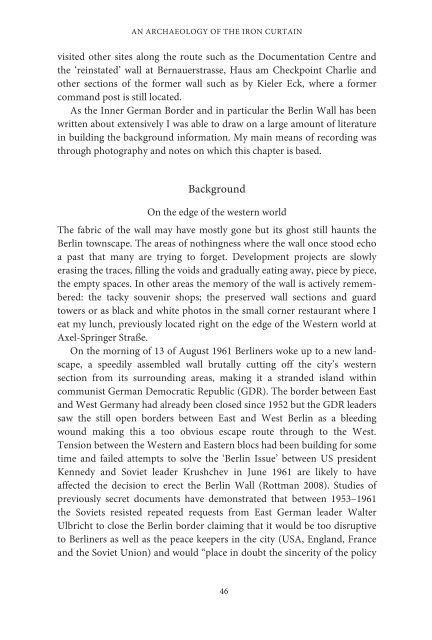1JZGauQ
1JZGauQ
1JZGauQ
Create successful ePaper yourself
Turn your PDF publications into a flip-book with our unique Google optimized e-Paper software.
AN ARCHAEOLOGY OF THE IRON CURTAIN<br />
visited other sites along the route such as the Documentation Centre and<br />
the ‘reinstated’ wall at Bernauerstrasse, Haus am Checkpoint Charlie and<br />
other sections of the former wall such as by Kieler Eck, where a former<br />
command post is still located.<br />
As the Inner German Border and in particular the Berlin Wall has been<br />
written about extensively I was able to draw on a large amount of literature<br />
in building the background information. My main means of recording was<br />
through photography and notes on which this chapter is based.<br />
Background<br />
On the edge of the western world<br />
The fabric of the wall may have mostly gone but its ghost still haunts the<br />
Berlin townscape. The areas of nothingness where the wall once stood echo<br />
a past that many are trying to forget. Development projects are slowly<br />
erasing the traces, filling the voids and gradually eating away, piece by piece,<br />
the empty spaces. In other areas the memory of the wall is actively remembered:<br />
the tacky souvenir shops; the preserved wall sections and guard<br />
towers or as black and white photos in the small corner restaurant where I<br />
eat my lunch, previously located right on the edge of the Western world at<br />
Axel-Springer Straße.<br />
On the morning of 13 of August 1961 Berliners woke up to a new landscape,<br />
a speedily assembled wall brutally cutting off the city’s western<br />
section from its surrounding areas, making it a stranded island within<br />
communist German Democratic Republic (GDR). The border between East<br />
and West Germany had already been closed since 1952 but the GDR leaders<br />
saw the still open borders between East and West Berlin as a bleeding<br />
wound making this a too obvious escape route through to the West.<br />
Tension between the Western and Eastern blocs had been building for some<br />
time and failed attempts to solve the ‘Berlin Issue’ between US president<br />
Kennedy and Soviet leader Krushchev in June 1961 are likely to have<br />
affected the decision to erect the Berlin Wall (Rottman 2008). Studies of<br />
previously secret documents have demonstrated that between 1953–1961<br />
the Soviets resisted repeated requests from East German leader Walter<br />
Ulbricht to close the Berlin border claiming that it would be too disruptive<br />
to Berliners as well as the peace keepers in the city (USA, England, France<br />
and the Soviet Union) and would “place in doubt the sincerity of the policy<br />
46




